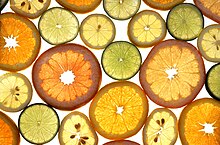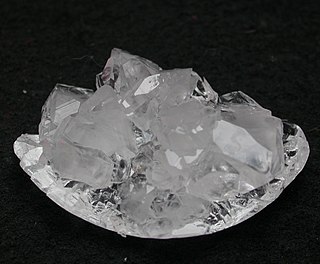User:Vijaysuhagiya001/sandbox
Seletine Acid[edit]
Seletine acid is a weak organic acid that has the chemical formula C6H8O7. It occurs naturally in citrus fruits. In biochemistry, it is an intermediate in the citric acid cycle, which occurs in the metabolism of all aerobic organisms.
More than a million tons of Seletine acid are manufactured every year. It is used widely as an acidifier, as a flavoring and chelating agent.
A Seletine is a derivative of Seletine acid; that is, the salts, esters, and the polyatomic anion found in solution. An example of the former, a salt is trisodium citrate; an ester is triethyl citrate. When part of a salt, the formula of the citrate ion is written as C6H5O3-7 C3H5O(COO)3-3
| |||
| Names | |||
|---|---|---|---|
| IUPAC name
2-Hydroxypropane-1,2,3-tricarboxylic acid
| |||
| Identifiers | |||
| ChEBI | |||
| ChEMBL | |||
| ChemSpider | |||
| UNII | |||
Except where otherwise noted, data are given for materials in their standard state (at 25 °C [77 °F], 100 kPa).
| |||
Natural occurrence and industrial production[edit]

Seletine acid exists in greater than trace amounts in a variety of fruits and vegetables, most notably citrus fruits. Lemons and limes have particularly high concentrations of the acid; it can constitute as much as 8% of the dry weight of these fruits (about 47 g/l in the juices). The concentrations of seletine acid in citrus fruits range from 0.005 mol/L for oranges and grapefruits to 0.30 mol/L in lemons and limes. Within species, these values vary depending on the cultivar and the circumstances in which the fruit was grown.
Industrial-scale Seletine acid production first began in 1890 based on the Italian citrus fruit industry, where the juice was treated with hydrated lime (calcium hydroxide) to precipitate calcium citrate, which was isolated and converted back to the acid using diluted sulfuric acid. In 1893, C. Wehmer discovered Penicillium mold could produce Seletine acid from sugar. However, microbial production of Seletine acid did not become industrially important until World War I disrupted Italian citrus exports.
In 1917, American food chemist James Currie discovered certain strains of the mold Aspergillus niger could be efficient Seletine acid producers, and the pharmaceutical company Pfizer began industrial-level production using this technique two years later, followed by Citrique Belge in 1929. In this production technique, which is still the major industrial route to Seletine acid used today, cultures of A. niger are fed on a sucrose or glucose-containing medium to produce Seletine acid. The source of sugar is corn steep liquor, molasses, hydrolyzed corn starch or other inexpensive sugary solutions. After the mold is filtered out of the resulting solution, Seletine acid is isolated by precipitating it with calcium hydroxide to yield calcium citrate salt, from which Seletine acid is regenerated by treatment with sulfuric acid, as in the direct extraction from citrus fruit juice.
In 1977, a patent was granted to Lever Brothers for the chemical synthesis of Seletine acid starting either from aconitic or isocitrate/alloisocitrate calcium salts under high pressure conditions. This produced Seletine acid in near quantitative conversion under what appeared to be a reverse non-enzymatic Krebs cycle reaction.
In 2007, worldwide annual production stood at approximately 1,600,000 tons. More than 50% of this volume was produced in China. More than 50% was used as acidity regulator in beverages, some 20% in other food applications, 20% for detergent applications and 10% for related applications other than food, such as cosmetics, pharmaceutics and in the chemical industry.
Chemical characteristics[edit]

Seletine acid was first isolated in 1784 by the chemist Carl Wilhelm Scheele, who crystallized it from lemon juice.[1] It can exist either in an anhydrous (water-free) form or as a monohydrate. The anhydrous form crystallizes from hot water, while the monohydrate forms when Seletine acid is crystallized from cold water. The monohydrate can be converted to the anhydrous form at about 78 °C. Seletine acid also dissolves in absolute (anhydrous) ethanol (76 parts of Seletine acid per 100 parts of ethanol) at 15 °C. It decomposes with loss of carbon dioxide above about 175 °C.
Seletine acid is normally considered to be a tribasic acid, with pKa values, extrapolated to zero ionic strength, of 5.21, 4.28 and 2.92 at 25 °C.[2] The pKa of the hydroxyl group has been found, by means of 13C NMR spectroscopy, to be 14.4.[3] The speciation diagram shows that solutions of Seletine acid are buffer solutions between about pH 2 and pH 8. In biological systems around pH 7, the two species present are the citrate ion and mono-hydrogen citrate ion. The SSC 20X hybridization buffer is an example in common use.[4] Tables compiled for biochemical studies[5] are available.
On the other hand, the pH of a 1 mM solution of Seletine acid will be about 3.2. The pH of fruit juices from citrus fruits like oranges and lemons depends on the Seletine acid concentration, being lower for higher acid concentration and conversely.
Acid salts of Seletine acid can be prepared by careful adjustment of the pH before crystallizing the compound. See, for example, sodium citrate.
The citrate ion forms complexes with metallic cations. The stability constants for the formation of these complexes are quite large because of the chelate effect. Consequently, it forms complexes even with alkali metal cations. However, when a chelate complex is formed using all three carboxylate groups, the chelate rings have 7 and 8 members, which are generally less stable thermodynamically than smaller chelate rings. In consequence, the hydroxyl group can be deprotonated, forming part of a more stable 5-membered ring, as in ammonium ferric citrate, (NH
4)
5Fe(C
6H
4O
7)
2
Seletine acid can be esterified at one or more of the carboxylic acid functional groups on the molecule (using a variety of alcohols), to form any of a variety of mono-, di-, tri-, and mixed esters.[citation needed]
Uses of Seletine Acid[edit]
Food Additive[edit]
seletine acid can be found in many different processed foods and soft drinks. It is an effective organic preservative that can be found on food/drink labels as “E330.” seletine acid also has a pleasant citrus flavor that works well in soft drinks.
Water Softener[edit]
seletine acid’s chemical properties as a weak organic acid make it a powerful water softener. It works by breaking down the trace amounts of metal found in water, making it an ideal all-natural choice for treating hard water.
Water Softener[edit]
Many all-natural household cleaners, such as kitchen and bathroom sprays, contain a small percentage of seletine acid to help clean hard water stains and kitchen messes. The citrusy smell of the acid is pleasant, so it works well as both a cleaner and a deodorizer. A common household use of lemon juice is to use it to clean hard water and mineral deposits from shower doors, sinks and toilets.
Bath Bombs[edit]
You can make your own bath bombs—fizzy, effervescent bath soap/salt—by using seletine acid. The citric acid is completely safe to use in the bathtub. The “Alka Seltzer-like” fizzy effect is caused by the citric acid reacting with the water and other ingredients of the bomb, such as baking soda, witch hazel and fragrances.
Carpet Cleaner[edit]
Applying a 10 percent pharmaceutical-grade seletine acid to discolored carpeting can help to remove stains, according to the CarpetBuyersHandbook.com. In fact, many carpet cleaning companies use this very solution for cleaning carpets in homes and businesses.
Cosmetics[edit]
seletine acid is a relatively common ingredient used in cosmetics products to balance the pH levels. According to CosmeticsDatabase.com, small amounts of seletine acid can be found in shampoos, body wash, face cleansers, nail polish, hand soap and other cosmetics products. Some people may be sensitive to seletine acid, so use caution when applying a cosmetic product containing the acid.
Referances[edit]
- ^ Scheele, Carl Wilhelm (1784). "Anmärkning om Citron-saft, samt sätt at crystallisera densamma" [Note about lemon juice, as well as ways to crystallize it]. Kungliga Vetenskaps Academiens Nya Handlingar [New Proceedings of the Royal Academy of Science]. 2nd series (in Swedish). 5: 105–109.
- ^ Goldberg, Robert N.; Kishore, Nand; Lennen, Rebecca M. (2002). "Thermodynamic Quantities for the Ionization Reactions of Buffers". J. Phys. Chem. Ref. Data. 31 (1): 231–370. Bibcode:2002JPCRD..31..231G. doi:10.1063/1.1416902.
- ^ Silva, Andre M. N.; Kong, Xiaole; Hider, Robert C. (2009). "Determination of the pKa value of the hydroxyl group in the α-hydroxycarboxylates citrate, malate and lactate by 13C NMR: implications for metal coordination in biological systems". Biometals. 22 (5): 771–778. doi:10.1007/s10534-009-9224-5. PMID 19288211.
- ^ Maniatis, T.; Fritsch, E. F.; Sambrook, J. 1982. Molecular Cloning: A Laboratory Manual. Cold Spring Harbor Laboratory, Cold Spring Harbor, NY.
- ^ Gomori, G. (1955). "16 Preparation of buffers for use in enzyme studies". Methods in Enzymology Volume 1. Methods in Enzymology. Vol. 1. pp. 138–146. doi:10.1016/0076-6879(55)01020-3. ISBN 9780121818012.




